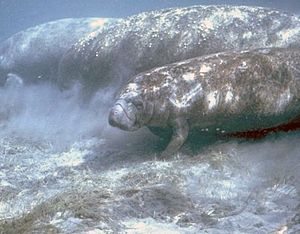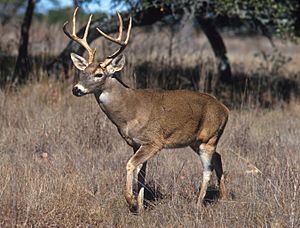List of mammals of Puerto Rico facts for kids
This article lists the amazing mammals found in Puerto Rico. You'll learn about different types of mammals, from tiny mice to giant whales! Some of these animals are doing well, while others need our help to survive. Two species are considered extinct, and a few others are vulnerable.
Scientists use special tags to show how safe an animal species is. This helps us know which animals need more protection. Here's what the tags mean:
| EX | Extinct | This means the last animal of its kind has died. It's gone forever. |
| EW | Extinct in the wild | These animals only live in zoos or special protected areas. They don't live freely in nature anymore. |
| CR | Critically endangered | These animals are in extreme danger of disappearing from the wild very soon. |
| EN | Endangered | These animals face a very high risk of disappearing from the wild. |
| VU | Vulnerable | These animals are at a high risk of disappearing from the wild. |
| NT | Near threatened | These animals are not in immediate danger, but they might be in the future. |
| LC | Least concern | These animals are doing well, and there are no big worries about them right now. |
| DD | Data deficient | We don't have enough information to know how safe these animals are. |
Some animals were assessed with older rules. For these, you might see these tags instead of "Near threatened" or "Least concern":
| LR/cd | Lower risk/conservation dependent | These animals needed special programs to help them. They might be in danger if those programs stopped. |
| LR/nt | Lower risk/near threatened | These animals are close to being vulnerable, but they don't have special conservation programs. |
| LR/lc | Lower risk/least concern | There are no known risks for these animals. |
Contents
Order: Sirenia (Manatees)
Sirenia is an order of mammals that live only in water. They eat plants and live in rivers, bays, and coastal waters. All four species of Sirenia in the world are endangered.
- Family: Trichechidae (Manatees)
- Genus: Trichechus
- West Indian manatee, T. manatus
- Genus: Trichechus
Order: Rodentia (Rodents)
Rodents are the largest group of mammals. More than 40% of all mammal species are rodents. They have two front teeth in their upper and lower jaws that never stop growing. They must gnaw on things to keep their teeth short. Most rodents are small.
- Suborder: Hystricomorpha
- Family: Echimyidae
- Subfamily: Heteropsomyinae
- Genus: Heteropsomys
- Subfamily: Heteropsomyinae
- Family: Echimyidae
* Insular cave rat, H. insulans
-
-
- Subfamily: Isolobodontinae
- Genus: Isolobodon
- Subfamily: Isolobodontinae
-
* Puerto Rican hutia, I. portoricensis (This species was introduced to Puerto Rico.)
- Suborder: Muridae
Order: Primates
The order Primates includes lemurs, monkeys, and apes. Humans are also part of this group.
- Family: Cercopithecidae (Old World Monkeys)
- Genus: Erythrocebus
- Common patas monkey, E. patas (This species was introduced to Puerto Rico.)
- Genus: Erythrocebus
Order: Chiroptera (Bats)
Bats are special because their front limbs are wings. This makes them the only mammals that can truly fly! About 20% of all mammal species are bats.
- Family: Noctilionidae (Bulldog Bats)
- Genus: Noctilio
- Greater bulldog bat, Noctilio leporinus LR/lc
- Genus: Noctilio
- Family: Vespertilionidae (Evening Bats)
- Subfamily: Vespertilioninae
- Genus: Lasiurus
- Eastern red bat, Lasiurus borealis LR/lc
- Genus: Lasiurus
- Subfamily: Vespertilioninae
- Family: Molossidae (Free-tailed Bats)
- Genus: Molossus
- Velvety free-tailed bat, Molossus molossus LR/lc
- Genus: Tadarida
- Mexican free-tailed bat, Tadarida brasiliensis LR/nt
- Genus: Molossus
- Family: Mormoopidae (Ghost-faced and Mustached Bats)
- Genus: Mormoops
- Antillean ghost-faced bat, Mormoops blainvillii LR/nt
- Genus: Pteronotus
- Parnell's mustached bat, Pteronotus parnellii LR/lc
- Sooty mustached bat, Pteronotus quadridens LR/nt
- Genus: Mormoops
- Family: Phyllostomidae (Leaf-nosed Bats)
- Subfamily: Phyllostominae
- Genus: Macrotus
- Waterhouse's leaf-nosed bat, Macrotus waterhousii (This bat is no longer found in Puerto Rico, meaning it is extirpated.) LR/lc
- Genus: Macrotus
- Subfamily: Brachyphyllinae
- Genus: Brachyphylla
- Antillean fruit-eating bat, Brachyphylla cavernarum LR/lc
- Genus: Brachyphylla
- Subfamily: Phyllonycterinae
- Genus: Phyllonycteris
- Puerto Rican flower bat, Phyllonycteris major EX
- Genus: Phyllonycteris
- Subfamily: Glossophaginae
- Genus: Monophyllus
- Insular single leaf bat, Monophyllus plethodon LC (This bat might also be extirpated from Puerto Rico.)
- Genus: Monophyllus
- Subfamily: Phyllostominae
*Puerto Rican long-nosed bat, M. p. prater
-
-
-
- Leach's single leaf bat, Monophyllus redmani LR/lc
-
- Subfamily: Stenodermatinae
- Genus: Artibeus
- Jamaican fruit bat, Artibeus jamaicensis LR/lc
- Genus: Stenoderma
- Red fruit bat, Stenoderma rufum VU
- Genus: Artibeus
-
Order: Cetacea (Whales and Dolphins)
The order Cetacea includes whales, dolphins, and porpoises. These mammals are perfectly suited for life in the water. They have smooth bodies with almost no hair, a thick layer of fat (blubber), and their front limbs and tail are shaped for swimming.
- Suborder: Mysticeti (Baleen Whales)
- Family: Balaenopteridae (Rorquals)
- Genus: Balaenoptera
- Common minke whale, Balaenoptera acutorostrata
- Sei whale, Balaenoptera borealis
- Bryde's whale, Balaenoptera brydei
- Blue whale, Balaenoptera musculus
- Genus: Megaptera
- Humpback whale, Megaptera novaeangliae
- Genus: Balaenoptera
- Family: Balaenopteridae (Rorquals)
- Suborder: Odontoceti (Toothed Whales)
- Superfamily: Platanistoidea
- Family: Delphinidae (Oceanic Dolphins)
- Genus: Delphinus
- Family: Delphinidae (Oceanic Dolphins)
- Superfamily: Platanistoidea
* Short-beaked common dolphin, Delphinus delphis DD
-
-
-
- Genus: Feresa
-
-
* Pygmy killer whale, Feresa attenuata DD
-
-
-
- Genus: Globicephala
-
-
* Short-finned pilot whale, Globicephala macrorhynchus DD
-
-
-
- Genus: Lagenodelphis
-
-
* Fraser's dolphin, Lagenodelphis hosei DD
-
-
-
- Genus: Grampus
-
-
* Risso's dolphin, Grampus griseus DD
-
-
-
- Genus: Orcinus
-
-
* Killer whale, Orcinus orca DD
-
-
-
- Genus: Peponocephala
-
-
* Melon-headed whale, Peponocephala electra DD
-
-
-
- Genus: Pseudorca
-
-
* False killer whale, Pseudorca crassidens DD
-
-
-
- Genus: Stenella
-
-
* Pantropical spotted dolphin, Stenella attenuata DD * Clymene dolphin, Stenella clymene DD * Striped dolphin, Stenella coeruleoalba DD * Atlantic spotted dolphin, Stenella frontalis DD * Spinner dolphin, Stenella longirostris DD
-
-
-
- Genus: Steno
-
-
* Rough-toothed dolphin, Steno bredanensis DD
-
-
-
- Genus: Tursiops
-
-
* Common bottlenose dolphin, Tursiops truncatus
-
-
- Family: Physeteridae (Sperm Whales)
- Genus: Physeter
- Family: Physeteridae (Sperm Whales)
-
* Sperm whale, Physeter catodon DD
-
-
- Family: Kogiidae (Dwarf Sperm Whales)
- Genus: Kogia
- Family: Kogiidae (Dwarf Sperm Whales)
-
* Pygmy sperm whale, Kogia breviceps DD * Dwarf sperm whale, Kogia sima DD
-
- Superfamily Ziphioidea
- Family: Ziphidae (Beaked Whales)
- Genus: Mesoplodon
- Family: Ziphidae (Beaked Whales)
- Superfamily Ziphioidea
* Gervais' beaked whale, Mesoplodon europaeus DD * Blainville's beaked whale, Mesoplodon densirostris DD * True's beaked whale, Mesoplodon mirus DD
-
-
-
- Genus: Ziphius
-
-
* Cuvier's beaked whale, Ziphius cavirostris DD
Order: Carnivora (Carnivores)
There are over 260 species of carnivores. Most of them eat mainly meat. They have a special skull shape and teeth for eating meat.
- Family: Herpestidae (Mongooses)
- Genus: Urva
- Small Indian mongoose, U. auropunctata (This species was introduced to Puerto Rico.)
- Genus: Urva
- Suborder: Pinnipedia (Seals)
- Family: Phocidae (Earless Seals)
- Genus: Cystophora
- Hooded seal, C. cristata (This seal is a rare visitor to Puerto Rico.)
- Genus: Neomonachus
- Caribbean monk seal, N. tropicalis (This seal is now extinct.)
- Genus: Cystophora
- Family: Phocidae (Earless Seals)
Order: Artiodactyla (Even-toed Hoofed Animals)
Even-toed ungulates are animals with hooves. They put their weight equally on two of their five toes: the third and fourth. The other three toes might be there, missing, or pointing backward.
- Family: Cervidae (Deer)
- Subfamily: Capreolinae
- Genus: Odocoileus
- White-tailed deer, O. virginianus (This species was introduced to Puerto Rico.)
- Genus: Odocoileus
- Subfamily: Capreolinae
See also
- List of chordate orders
- Lists of mammals by region
- List of prehistoric mammals
- Mammal classification
- List of mammals described in the 2000s




